Bri-Tech's Communication Challenges: A Report on Return-to-Office
VerifiedAdded on 2023/06/12
|8
|2179
|298
Report
AI Summary
This report analyzes the communication challenges faced by Bri-Tech, a multinational IT company, in its efforts to bring employees back to the office after the pandemic. It explores general theories of organizational communication, including Weber's Classic Organizational Theory and Tompkins and Cheney’s Organizational Theory, to understand the flow of information and control within the organization. The report identifies physical, emotional, organizational structure, perceptual, and interpersonal barriers that contribute to employee reluctance. Furthermore, it proposes strategies to overcome these barriers, such as providing transportation services, offering flexible schedules, adopting proper ventilation and space management, promoting effective communication and ethical listening, and implementing training and development programs to boost employee confidence and interpersonal skills. The report concludes that by addressing these barriers and implementing the suggested strategies, Bri-Tech can create a more supportive and communicative environment, facilitating a smoother transition back to the office for its employees.
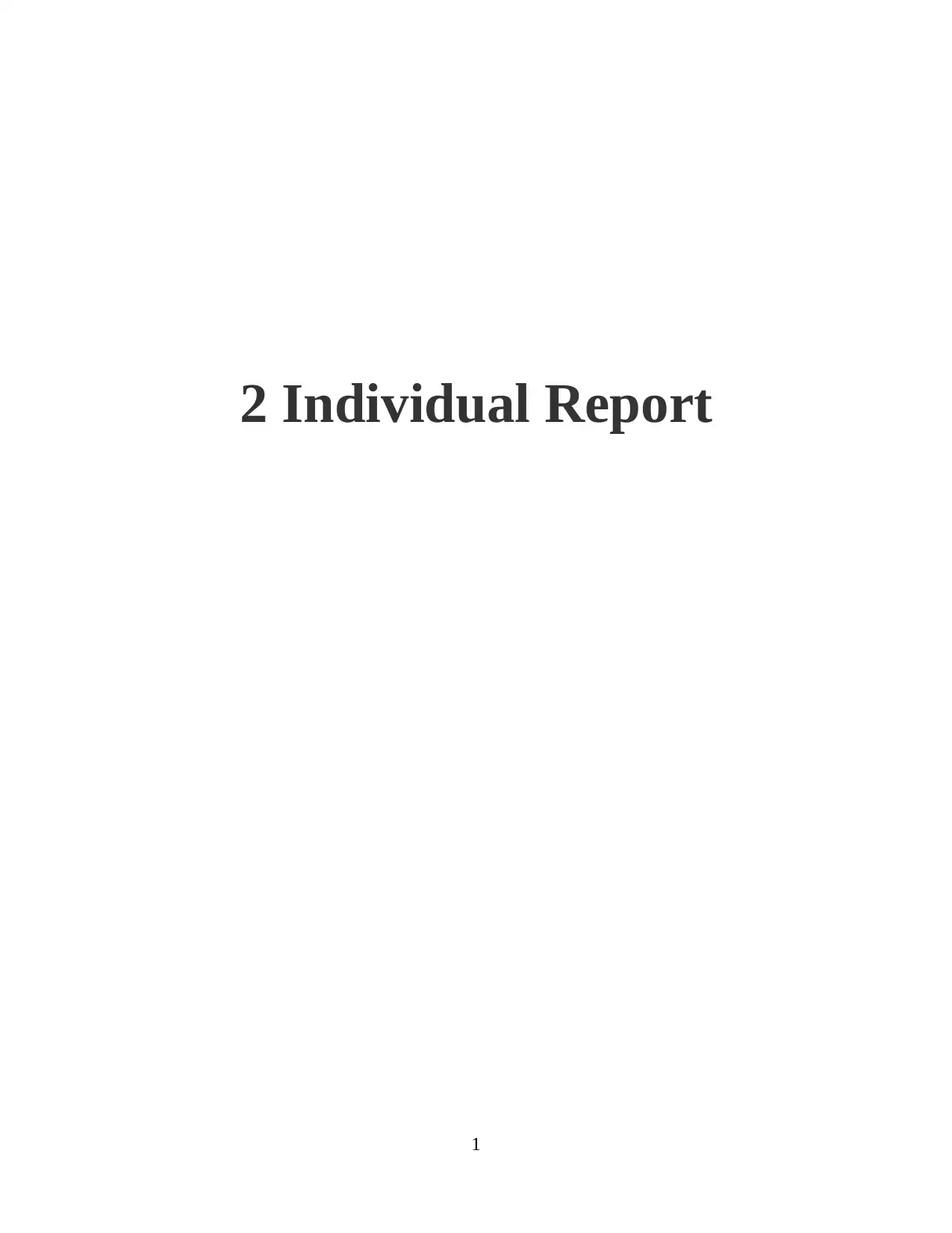
2 Individual Report
1
1
Paraphrase This Document
Need a fresh take? Get an instant paraphrase of this document with our AI Paraphraser
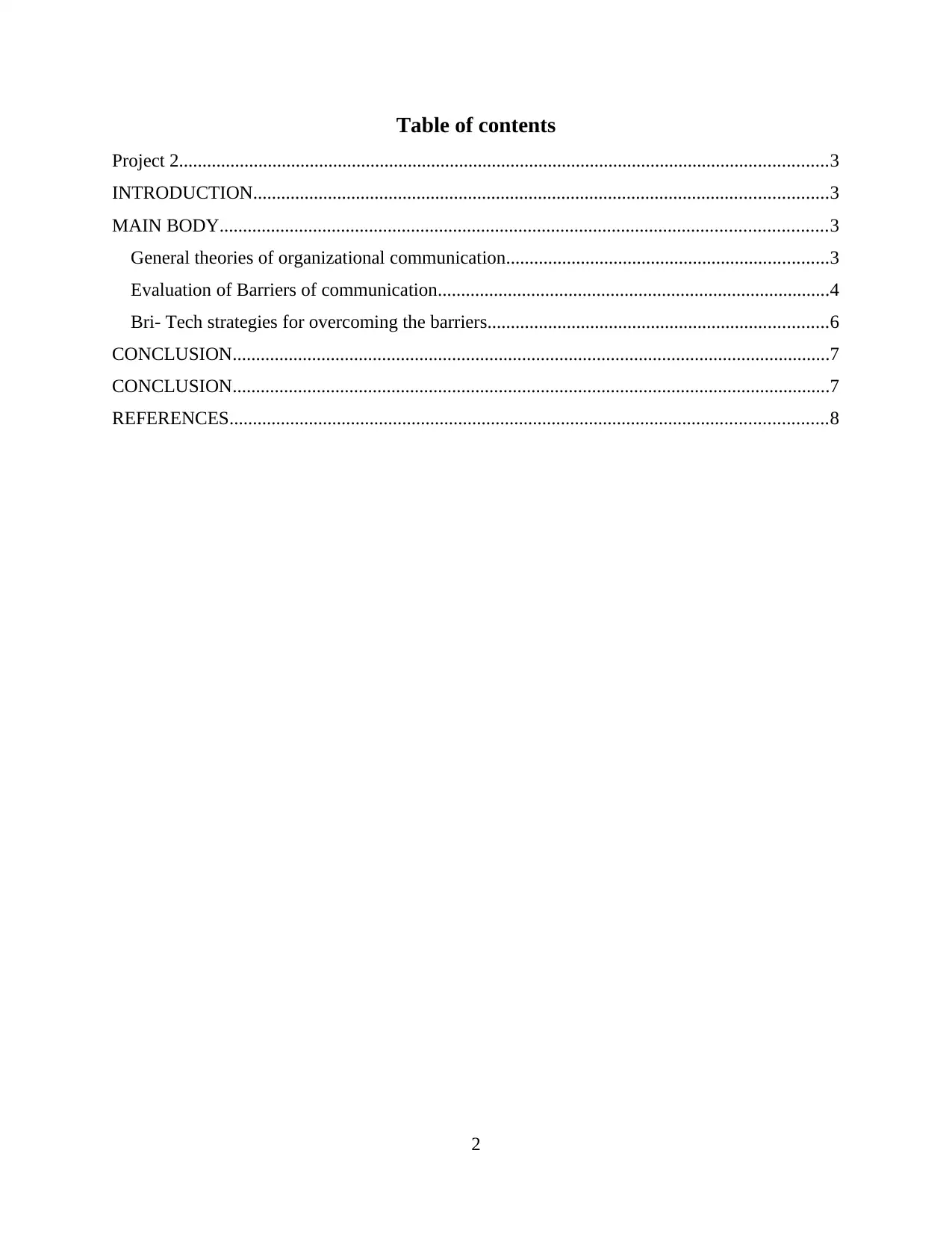
Table of contents
Project 2...........................................................................................................................................3
INTRODUCTION...........................................................................................................................3
MAIN BODY..................................................................................................................................3
General theories of organizational communication.....................................................................3
Evaluation of Barriers of communication....................................................................................4
Bri- Tech strategies for overcoming the barriers.........................................................................6
CONCLUSION................................................................................................................................7
CONCLUSION................................................................................................................................7
REFERENCES................................................................................................................................8
2
Project 2...........................................................................................................................................3
INTRODUCTION...........................................................................................................................3
MAIN BODY..................................................................................................................................3
General theories of organizational communication.....................................................................3
Evaluation of Barriers of communication....................................................................................4
Bri- Tech strategies for overcoming the barriers.........................................................................6
CONCLUSION................................................................................................................................7
CONCLUSION................................................................................................................................7
REFERENCES................................................................................................................................8
2
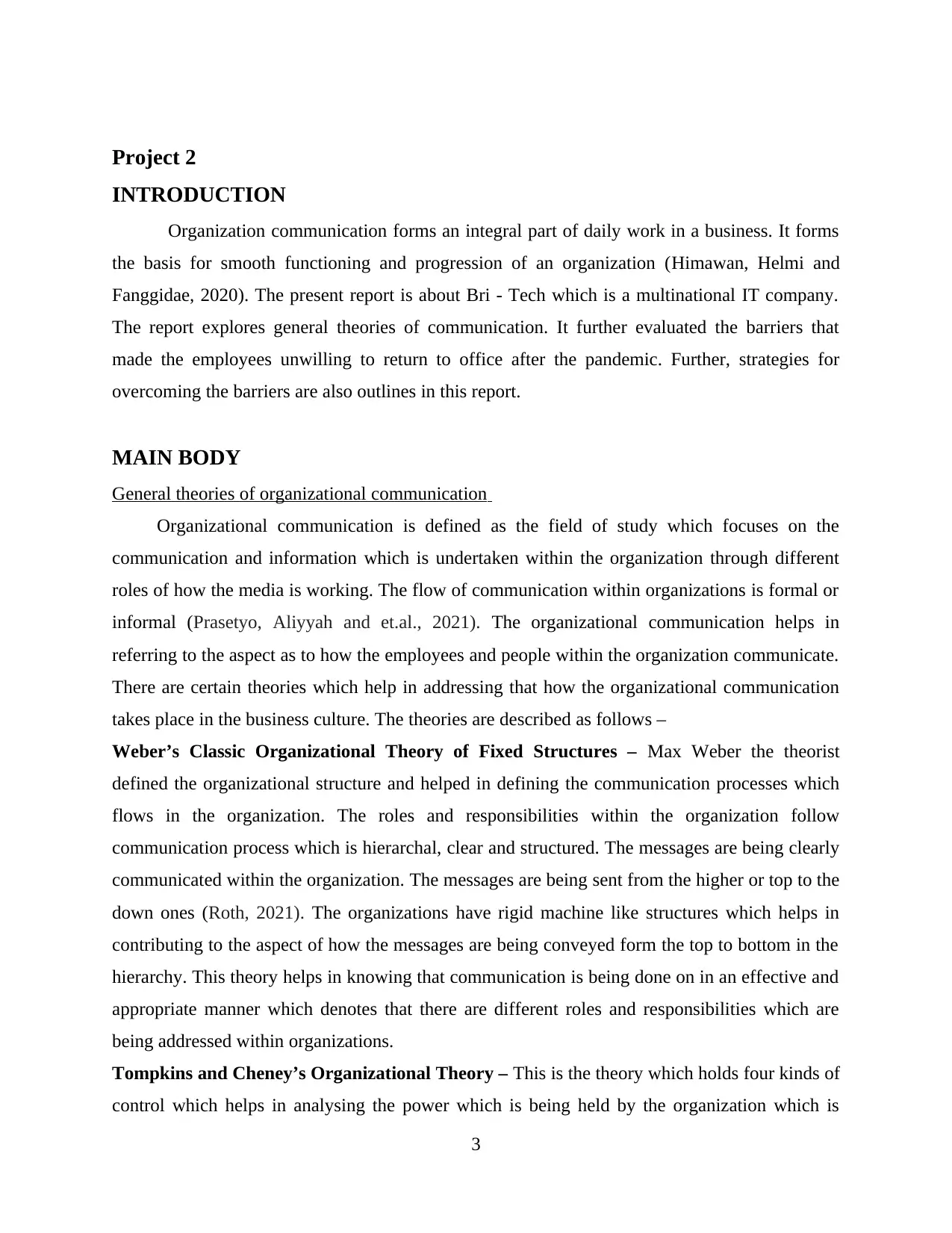
Project 2
INTRODUCTION
Organization communication forms an integral part of daily work in a business. It forms
the basis for smooth functioning and progression of an organization (Himawan, Helmi and
Fanggidae, 2020). The present report is about Bri - Tech which is a multinational IT company.
The report explores general theories of communication. It further evaluated the barriers that
made the employees unwilling to return to office after the pandemic. Further, strategies for
overcoming the barriers are also outlines in this report.
MAIN BODY
General theories of organizational communication
Organizational communication is defined as the field of study which focuses on the
communication and information which is undertaken within the organization through different
roles of how the media is working. The flow of communication within organizations is formal or
informal (Prasetyo, Aliyyah and et.al., 2021). The organizational communication helps in
referring to the aspect as to how the employees and people within the organization communicate.
There are certain theories which help in addressing that how the organizational communication
takes place in the business culture. The theories are described as follows –
Weber’s Classic Organizational Theory of Fixed Structures – Max Weber the theorist
defined the organizational structure and helped in defining the communication processes which
flows in the organization. The roles and responsibilities within the organization follow
communication process which is hierarchal, clear and structured. The messages are being clearly
communicated within the organization. The messages are being sent from the higher or top to the
down ones (Roth, 2021). The organizations have rigid machine like structures which helps in
contributing to the aspect of how the messages are being conveyed form the top to bottom in the
hierarchy. This theory helps in knowing that communication is being done on in an effective and
appropriate manner which denotes that there are different roles and responsibilities which are
being addressed within organizations.
Tompkins and Cheney’s Organizational Theory – This is the theory which holds four kinds of
control which helps in analysing the power which is being held by the organization which is
3
INTRODUCTION
Organization communication forms an integral part of daily work in a business. It forms
the basis for smooth functioning and progression of an organization (Himawan, Helmi and
Fanggidae, 2020). The present report is about Bri - Tech which is a multinational IT company.
The report explores general theories of communication. It further evaluated the barriers that
made the employees unwilling to return to office after the pandemic. Further, strategies for
overcoming the barriers are also outlines in this report.
MAIN BODY
General theories of organizational communication
Organizational communication is defined as the field of study which focuses on the
communication and information which is undertaken within the organization through different
roles of how the media is working. The flow of communication within organizations is formal or
informal (Prasetyo, Aliyyah and et.al., 2021). The organizational communication helps in
referring to the aspect as to how the employees and people within the organization communicate.
There are certain theories which help in addressing that how the organizational communication
takes place in the business culture. The theories are described as follows –
Weber’s Classic Organizational Theory of Fixed Structures – Max Weber the theorist
defined the organizational structure and helped in defining the communication processes which
flows in the organization. The roles and responsibilities within the organization follow
communication process which is hierarchal, clear and structured. The messages are being clearly
communicated within the organization. The messages are being sent from the higher or top to the
down ones (Roth, 2021). The organizations have rigid machine like structures which helps in
contributing to the aspect of how the messages are being conveyed form the top to bottom in the
hierarchy. This theory helps in knowing that communication is being done on in an effective and
appropriate manner which denotes that there are different roles and responsibilities which are
being addressed within organizations.
Tompkins and Cheney’s Organizational Theory – This is the theory which holds four kinds of
control which helps in analysing the power which is being held by the organization which is
3
⊘ This is a preview!⊘
Do you want full access?
Subscribe today to unlock all pages.

Trusted by 1+ million students worldwide
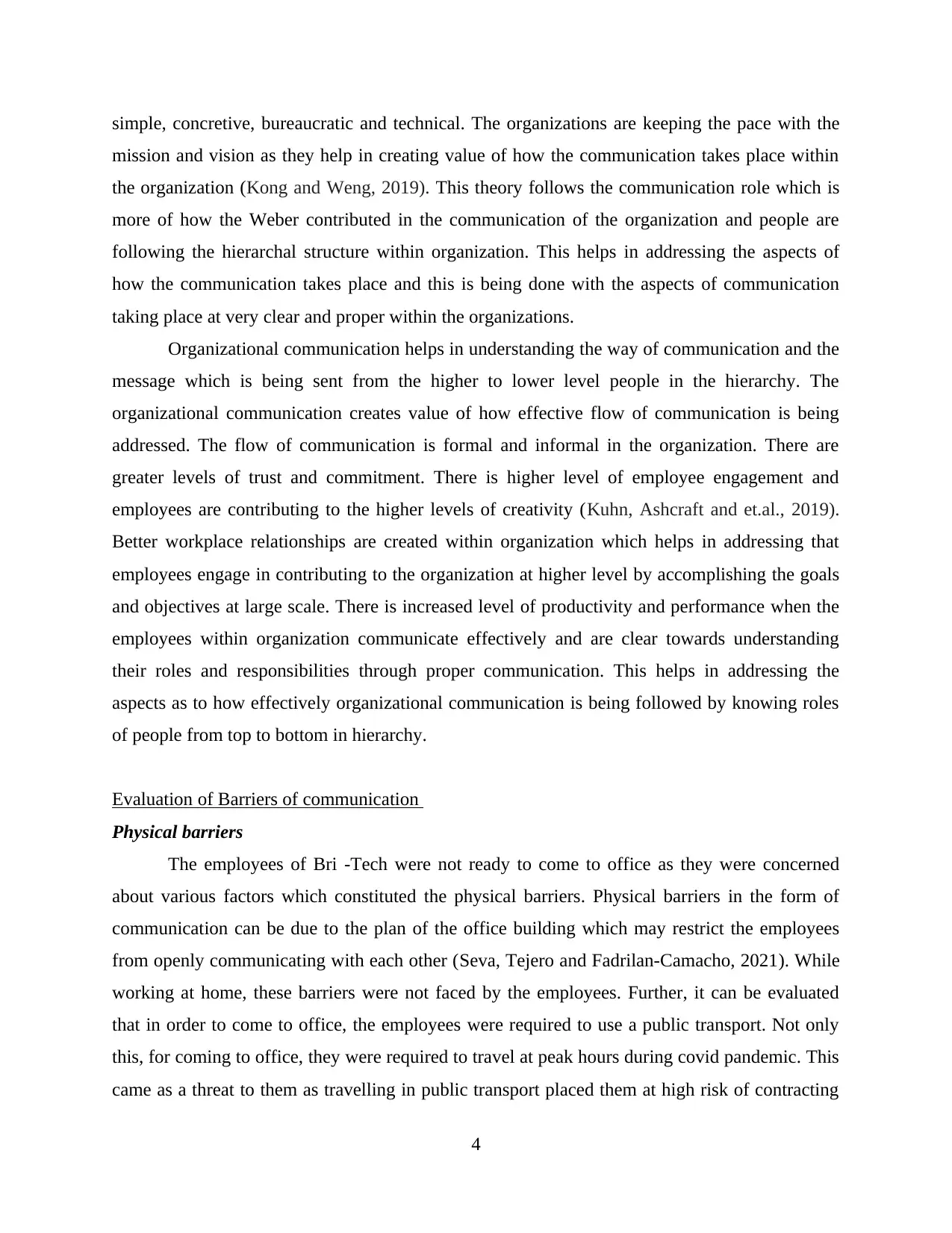
simple, concretive, bureaucratic and technical. The organizations are keeping the pace with the
mission and vision as they help in creating value of how the communication takes place within
the organization (Kong and Weng, 2019). This theory follows the communication role which is
more of how the Weber contributed in the communication of the organization and people are
following the hierarchal structure within organization. This helps in addressing the aspects of
how the communication takes place and this is being done with the aspects of communication
taking place at very clear and proper within the organizations.
Organizational communication helps in understanding the way of communication and the
message which is being sent from the higher to lower level people in the hierarchy. The
organizational communication creates value of how effective flow of communication is being
addressed. The flow of communication is formal and informal in the organization. There are
greater levels of trust and commitment. There is higher level of employee engagement and
employees are contributing to the higher levels of creativity (Kuhn, Ashcraft and et.al., 2019).
Better workplace relationships are created within organization which helps in addressing that
employees engage in contributing to the organization at higher level by accomplishing the goals
and objectives at large scale. There is increased level of productivity and performance when the
employees within organization communicate effectively and are clear towards understanding
their roles and responsibilities through proper communication. This helps in addressing the
aspects as to how effectively organizational communication is being followed by knowing roles
of people from top to bottom in hierarchy.
Evaluation of Barriers of communication
Physical barriers
The employees of Bri -Tech were not ready to come to office as they were concerned
about various factors which constituted the physical barriers. Physical barriers in the form of
communication can be due to the plan of the office building which may restrict the employees
from openly communicating with each other (Seva, Tejero and Fadrilan-Camacho, 2021). While
working at home, these barriers were not faced by the employees. Further, it can be evaluated
that in order to come to office, the employees were required to use a public transport. Not only
this, for coming to office, they were required to travel at peak hours during covid pandemic. This
came as a threat to them as travelling in public transport placed them at high risk of contracting
4
mission and vision as they help in creating value of how the communication takes place within
the organization (Kong and Weng, 2019). This theory follows the communication role which is
more of how the Weber contributed in the communication of the organization and people are
following the hierarchal structure within organization. This helps in addressing the aspects of
how the communication takes place and this is being done with the aspects of communication
taking place at very clear and proper within the organizations.
Organizational communication helps in understanding the way of communication and the
message which is being sent from the higher to lower level people in the hierarchy. The
organizational communication creates value of how effective flow of communication is being
addressed. The flow of communication is formal and informal in the organization. There are
greater levels of trust and commitment. There is higher level of employee engagement and
employees are contributing to the higher levels of creativity (Kuhn, Ashcraft and et.al., 2019).
Better workplace relationships are created within organization which helps in addressing that
employees engage in contributing to the organization at higher level by accomplishing the goals
and objectives at large scale. There is increased level of productivity and performance when the
employees within organization communicate effectively and are clear towards understanding
their roles and responsibilities through proper communication. This helps in addressing the
aspects as to how effectively organizational communication is being followed by knowing roles
of people from top to bottom in hierarchy.
Evaluation of Barriers of communication
Physical barriers
The employees of Bri -Tech were not ready to come to office as they were concerned
about various factors which constituted the physical barriers. Physical barriers in the form of
communication can be due to the plan of the office building which may restrict the employees
from openly communicating with each other (Seva, Tejero and Fadrilan-Camacho, 2021). While
working at home, these barriers were not faced by the employees. Further, it can be evaluated
that in order to come to office, the employees were required to use a public transport. Not only
this, for coming to office, they were required to travel at peak hours during covid pandemic. This
came as a threat to them as travelling in public transport placed them at high risk of contracting
4
Paraphrase This Document
Need a fresh take? Get an instant paraphrase of this document with our AI Paraphraser
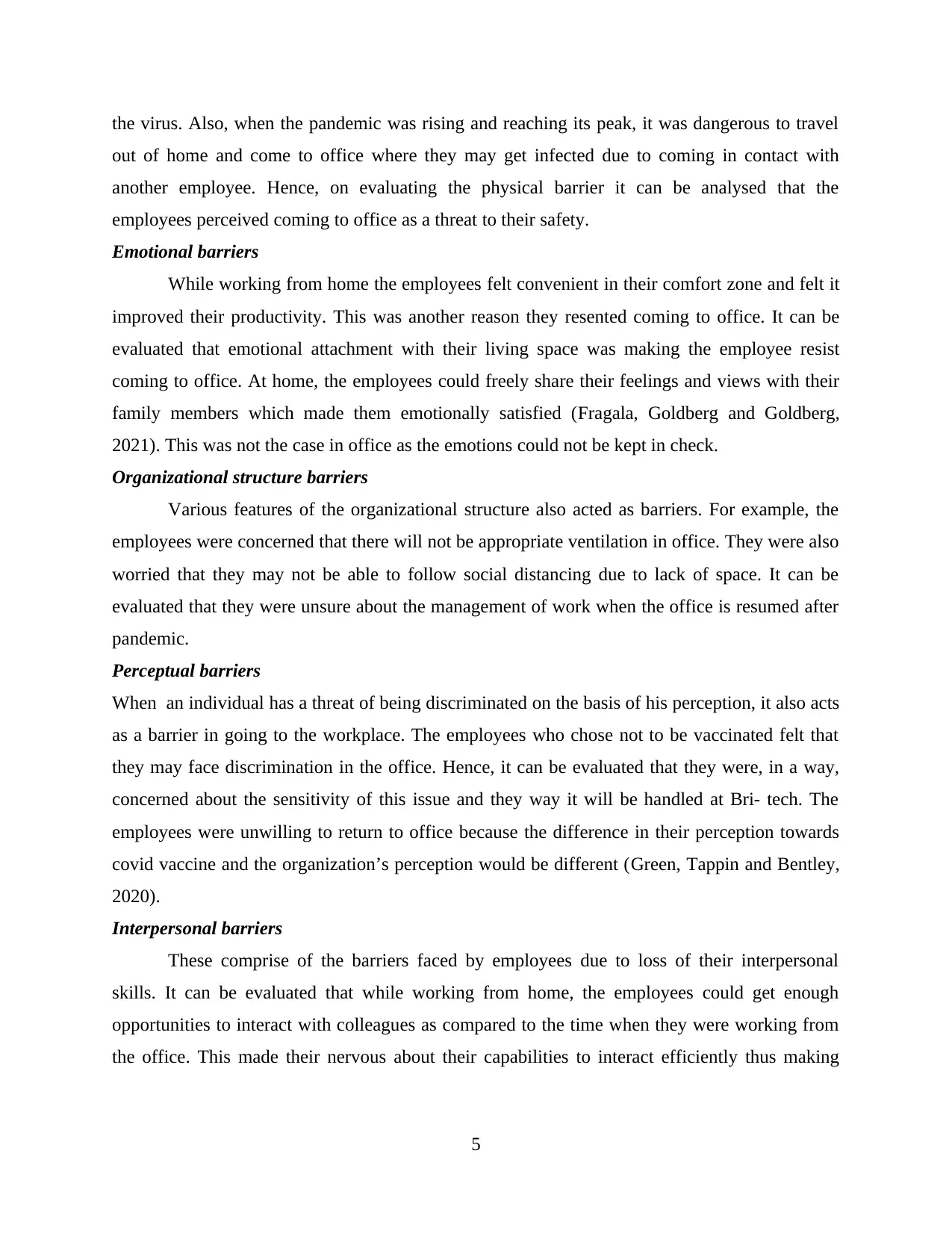
the virus. Also, when the pandemic was rising and reaching its peak, it was dangerous to travel
out of home and come to office where they may get infected due to coming in contact with
another employee. Hence, on evaluating the physical barrier it can be analysed that the
employees perceived coming to office as a threat to their safety.
Emotional barriers
While working from home the employees felt convenient in their comfort zone and felt it
improved their productivity. This was another reason they resented coming to office. It can be
evaluated that emotional attachment with their living space was making the employee resist
coming to office. At home, the employees could freely share their feelings and views with their
family members which made them emotionally satisfied (Fragala, Goldberg and Goldberg,
2021). This was not the case in office as the emotions could not be kept in check.
Organizational structure barriers
Various features of the organizational structure also acted as barriers. For example, the
employees were concerned that there will not be appropriate ventilation in office. They were also
worried that they may not be able to follow social distancing due to lack of space. It can be
evaluated that they were unsure about the management of work when the office is resumed after
pandemic.
Perceptual barriers
When an individual has a threat of being discriminated on the basis of his perception, it also acts
as a barrier in going to the workplace. The employees who chose not to be vaccinated felt that
they may face discrimination in the office. Hence, it can be evaluated that they were, in a way,
concerned about the sensitivity of this issue and they way it will be handled at Bri- tech. The
employees were unwilling to return to office because the difference in their perception towards
covid vaccine and the organization’s perception would be different (Green, Tappin and Bentley,
2020).
Interpersonal barriers
These comprise of the barriers faced by employees due to loss of their interpersonal
skills. It can be evaluated that while working from home, the employees could get enough
opportunities to interact with colleagues as compared to the time when they were working from
the office. This made their nervous about their capabilities to interact efficiently thus making
5
out of home and come to office where they may get infected due to coming in contact with
another employee. Hence, on evaluating the physical barrier it can be analysed that the
employees perceived coming to office as a threat to their safety.
Emotional barriers
While working from home the employees felt convenient in their comfort zone and felt it
improved their productivity. This was another reason they resented coming to office. It can be
evaluated that emotional attachment with their living space was making the employee resist
coming to office. At home, the employees could freely share their feelings and views with their
family members which made them emotionally satisfied (Fragala, Goldberg and Goldberg,
2021). This was not the case in office as the emotions could not be kept in check.
Organizational structure barriers
Various features of the organizational structure also acted as barriers. For example, the
employees were concerned that there will not be appropriate ventilation in office. They were also
worried that they may not be able to follow social distancing due to lack of space. It can be
evaluated that they were unsure about the management of work when the office is resumed after
pandemic.
Perceptual barriers
When an individual has a threat of being discriminated on the basis of his perception, it also acts
as a barrier in going to the workplace. The employees who chose not to be vaccinated felt that
they may face discrimination in the office. Hence, it can be evaluated that they were, in a way,
concerned about the sensitivity of this issue and they way it will be handled at Bri- tech. The
employees were unwilling to return to office because the difference in their perception towards
covid vaccine and the organization’s perception would be different (Green, Tappin and Bentley,
2020).
Interpersonal barriers
These comprise of the barriers faced by employees due to loss of their interpersonal
skills. It can be evaluated that while working from home, the employees could get enough
opportunities to interact with colleagues as compared to the time when they were working from
the office. This made their nervous about their capabilities to interact efficiently thus making
5
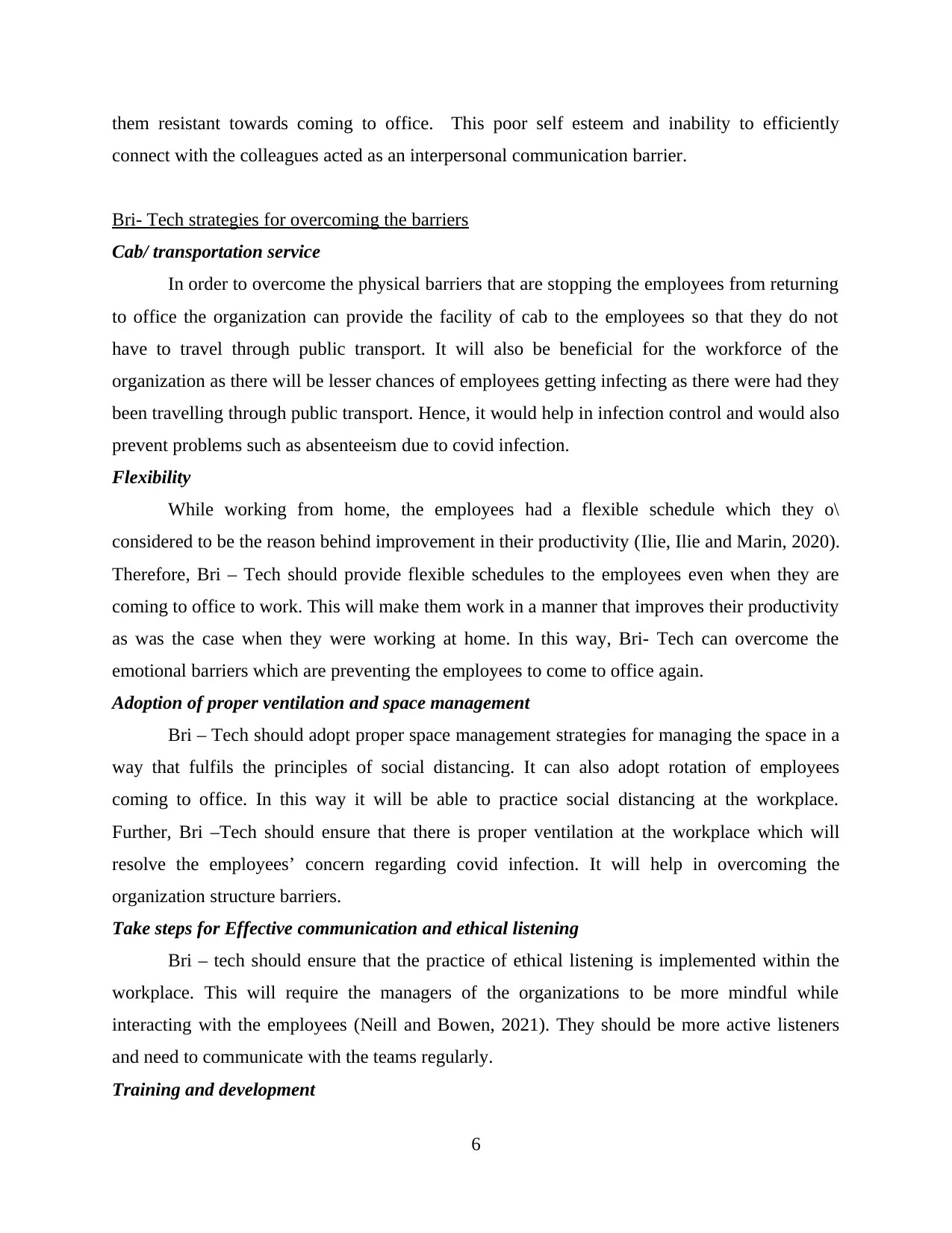
them resistant towards coming to office. This poor self esteem and inability to efficiently
connect with the colleagues acted as an interpersonal communication barrier.
Bri- Tech strategies for overcoming the barriers
Cab/ transportation service
In order to overcome the physical barriers that are stopping the employees from returning
to office the organization can provide the facility of cab to the employees so that they do not
have to travel through public transport. It will also be beneficial for the workforce of the
organization as there will be lesser chances of employees getting infecting as there were had they
been travelling through public transport. Hence, it would help in infection control and would also
prevent problems such as absenteeism due to covid infection.
Flexibility
While working from home, the employees had a flexible schedule which they o\
considered to be the reason behind improvement in their productivity (Ilie, Ilie and Marin, 2020).
Therefore, Bri – Tech should provide flexible schedules to the employees even when they are
coming to office to work. This will make them work in a manner that improves their productivity
as was the case when they were working at home. In this way, Bri- Tech can overcome the
emotional barriers which are preventing the employees to come to office again.
Adoption of proper ventilation and space management
Bri – Tech should adopt proper space management strategies for managing the space in a
way that fulfils the principles of social distancing. It can also adopt rotation of employees
coming to office. In this way it will be able to practice social distancing at the workplace.
Further, Bri –Tech should ensure that there is proper ventilation at the workplace which will
resolve the employees’ concern regarding covid infection. It will help in overcoming the
organization structure barriers.
Take steps for Effective communication and ethical listening
Bri – tech should ensure that the practice of ethical listening is implemented within the
workplace. This will require the managers of the organizations to be more mindful while
interacting with the employees (Neill and Bowen, 2021). They should be more active listeners
and need to communicate with the teams regularly.
Training and development
6
connect with the colleagues acted as an interpersonal communication barrier.
Bri- Tech strategies for overcoming the barriers
Cab/ transportation service
In order to overcome the physical barriers that are stopping the employees from returning
to office the organization can provide the facility of cab to the employees so that they do not
have to travel through public transport. It will also be beneficial for the workforce of the
organization as there will be lesser chances of employees getting infecting as there were had they
been travelling through public transport. Hence, it would help in infection control and would also
prevent problems such as absenteeism due to covid infection.
Flexibility
While working from home, the employees had a flexible schedule which they o\
considered to be the reason behind improvement in their productivity (Ilie, Ilie and Marin, 2020).
Therefore, Bri – Tech should provide flexible schedules to the employees even when they are
coming to office to work. This will make them work in a manner that improves their productivity
as was the case when they were working at home. In this way, Bri- Tech can overcome the
emotional barriers which are preventing the employees to come to office again.
Adoption of proper ventilation and space management
Bri – Tech should adopt proper space management strategies for managing the space in a
way that fulfils the principles of social distancing. It can also adopt rotation of employees
coming to office. In this way it will be able to practice social distancing at the workplace.
Further, Bri –Tech should ensure that there is proper ventilation at the workplace which will
resolve the employees’ concern regarding covid infection. It will help in overcoming the
organization structure barriers.
Take steps for Effective communication and ethical listening
Bri – tech should ensure that the practice of ethical listening is implemented within the
workplace. This will require the managers of the organizations to be more mindful while
interacting with the employees (Neill and Bowen, 2021). They should be more active listeners
and need to communicate with the teams regularly.
Training and development
6
⊘ This is a preview!⊘
Do you want full access?
Subscribe today to unlock all pages.

Trusted by 1+ million students worldwide
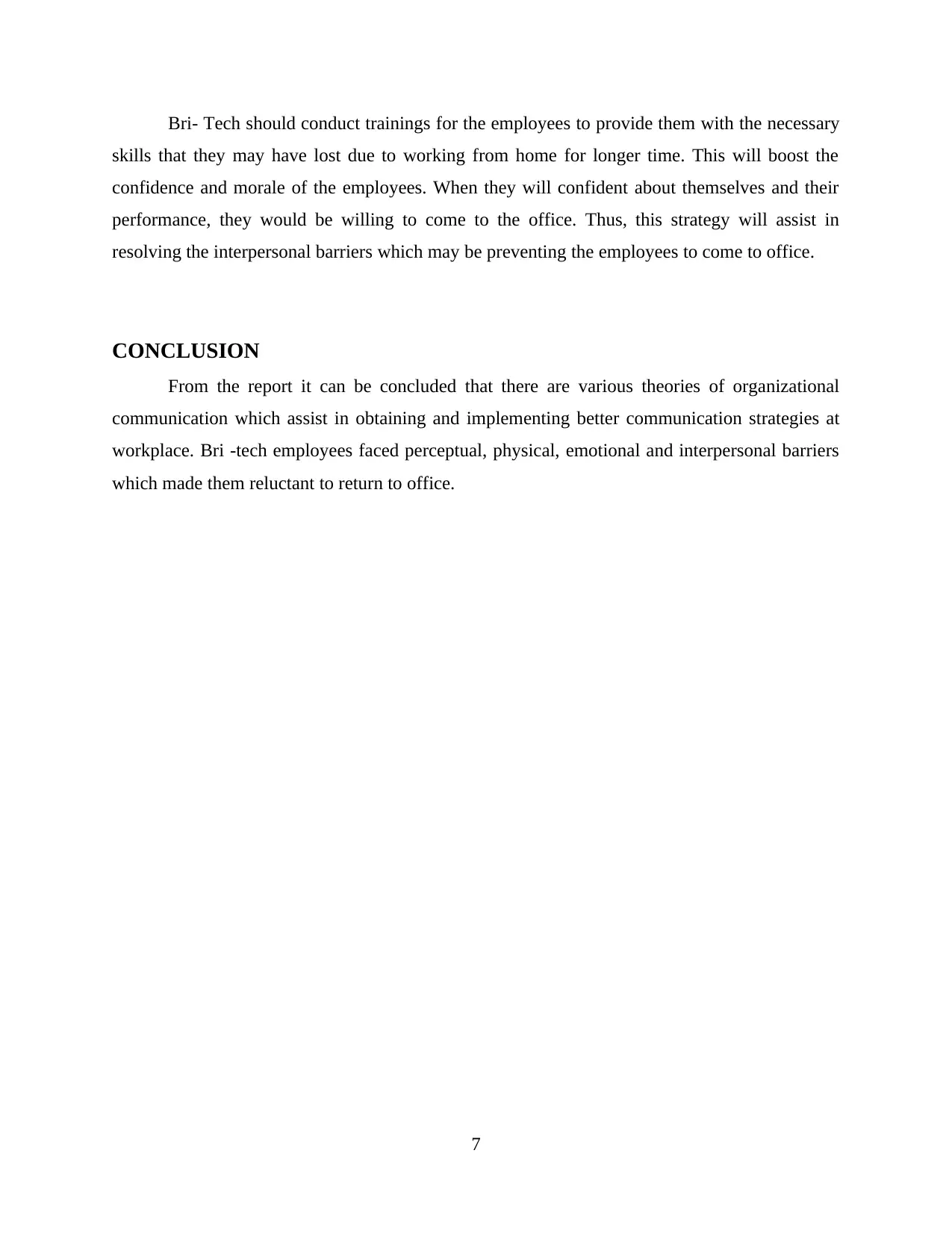
Bri- Tech should conduct trainings for the employees to provide them with the necessary
skills that they may have lost due to working from home for longer time. This will boost the
confidence and morale of the employees. When they will confident about themselves and their
performance, they would be willing to come to the office. Thus, this strategy will assist in
resolving the interpersonal barriers which may be preventing the employees to come to office.
CONCLUSION
From the report it can be concluded that there are various theories of organizational
communication which assist in obtaining and implementing better communication strategies at
workplace. Bri -tech employees faced perceptual, physical, emotional and interpersonal barriers
which made them reluctant to return to office.
7
skills that they may have lost due to working from home for longer time. This will boost the
confidence and morale of the employees. When they will confident about themselves and their
performance, they would be willing to come to the office. Thus, this strategy will assist in
resolving the interpersonal barriers which may be preventing the employees to come to office.
CONCLUSION
From the report it can be concluded that there are various theories of organizational
communication which assist in obtaining and implementing better communication strategies at
workplace. Bri -tech employees faced perceptual, physical, emotional and interpersonal barriers
which made them reluctant to return to office.
7
Paraphrase This Document
Need a fresh take? Get an instant paraphrase of this document with our AI Paraphraser
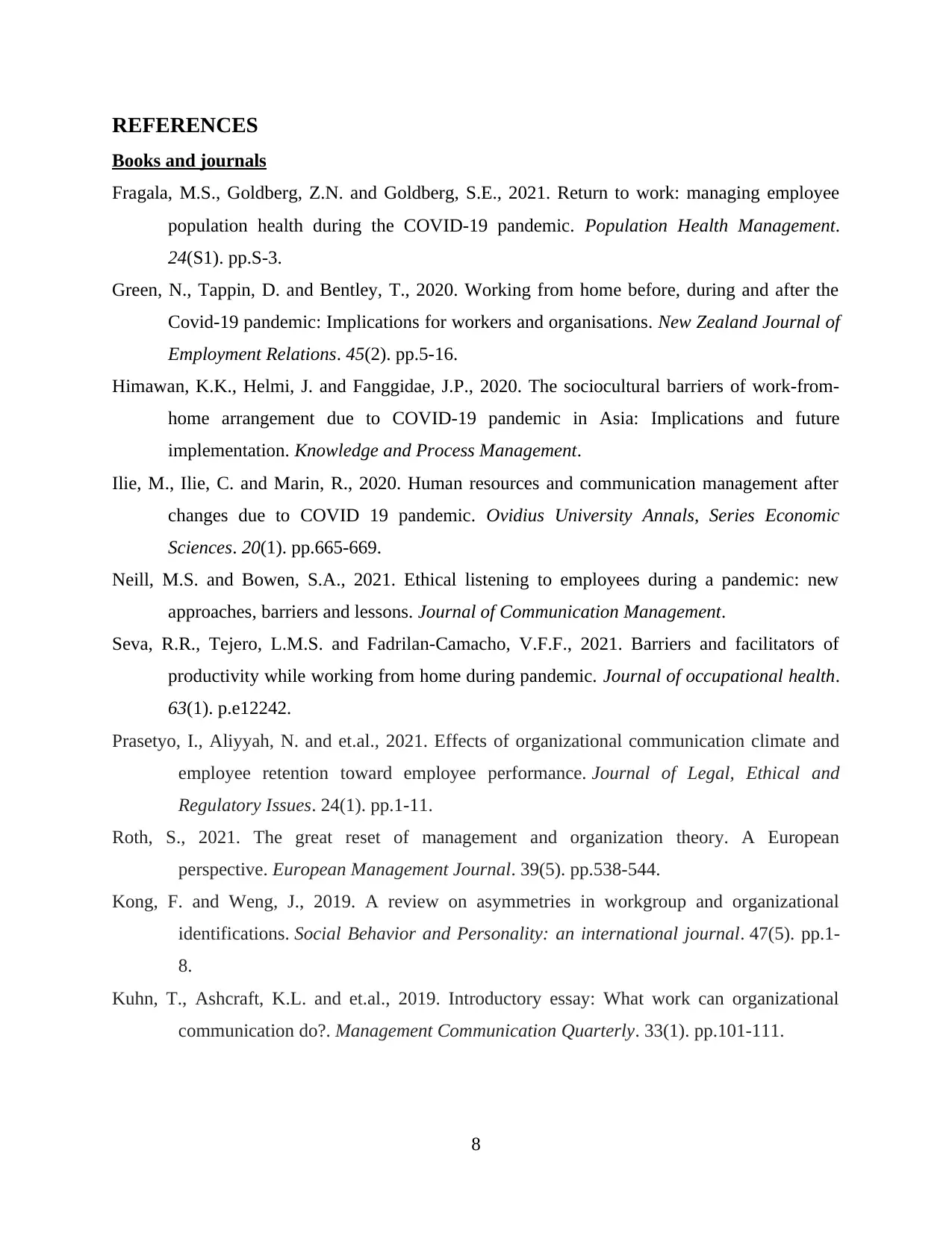
REFERENCES
Books and journals
Fragala, M.S., Goldberg, Z.N. and Goldberg, S.E., 2021. Return to work: managing employee
population health during the COVID-19 pandemic. Population Health Management.
24(S1). pp.S-3.
Green, N., Tappin, D. and Bentley, T., 2020. Working from home before, during and after the
Covid-19 pandemic: Implications for workers and organisations. New Zealand Journal of
Employment Relations. 45(2). pp.5-16.
Himawan, K.K., Helmi, J. and Fanggidae, J.P., 2020. The sociocultural barriers of work‐from‐
home arrangement due to COVID‐19 pandemic in Asia: Implications and future
implementation. Knowledge and Process Management.
Ilie, M., Ilie, C. and Marin, R., 2020. Human resources and communication management after
changes due to COVID 19 pandemic. Ovidius University Annals, Series Economic
Sciences. 20(1). pp.665-669.
Neill, M.S. and Bowen, S.A., 2021. Ethical listening to employees during a pandemic: new
approaches, barriers and lessons. Journal of Communication Management.
Seva, R.R., Tejero, L.M.S. and Fadrilan-Camacho, V.F.F., 2021. Barriers and facilitators of
productivity while working from home during pandemic. Journal of occupational health.
63(1). p.e12242.
Prasetyo, I., Aliyyah, N. and et.al., 2021. Effects of organizational communication climate and
employee retention toward employee performance. Journal of Legal, Ethical and
Regulatory Issues. 24(1). pp.1-11.
Roth, S., 2021. The great reset of management and organization theory. A European
perspective. European Management Journal. 39(5). pp.538-544.
Kong, F. and Weng, J., 2019. A review on asymmetries in workgroup and organizational
identifications. Social Behavior and Personality: an international journal. 47(5). pp.1-
8.
Kuhn, T., Ashcraft, K.L. and et.al., 2019. Introductory essay: What work can organizational
communication do?. Management Communication Quarterly. 33(1). pp.101-111.
8
Books and journals
Fragala, M.S., Goldberg, Z.N. and Goldberg, S.E., 2021. Return to work: managing employee
population health during the COVID-19 pandemic. Population Health Management.
24(S1). pp.S-3.
Green, N., Tappin, D. and Bentley, T., 2020. Working from home before, during and after the
Covid-19 pandemic: Implications for workers and organisations. New Zealand Journal of
Employment Relations. 45(2). pp.5-16.
Himawan, K.K., Helmi, J. and Fanggidae, J.P., 2020. The sociocultural barriers of work‐from‐
home arrangement due to COVID‐19 pandemic in Asia: Implications and future
implementation. Knowledge and Process Management.
Ilie, M., Ilie, C. and Marin, R., 2020. Human resources and communication management after
changes due to COVID 19 pandemic. Ovidius University Annals, Series Economic
Sciences. 20(1). pp.665-669.
Neill, M.S. and Bowen, S.A., 2021. Ethical listening to employees during a pandemic: new
approaches, barriers and lessons. Journal of Communication Management.
Seva, R.R., Tejero, L.M.S. and Fadrilan-Camacho, V.F.F., 2021. Barriers and facilitators of
productivity while working from home during pandemic. Journal of occupational health.
63(1). p.e12242.
Prasetyo, I., Aliyyah, N. and et.al., 2021. Effects of organizational communication climate and
employee retention toward employee performance. Journal of Legal, Ethical and
Regulatory Issues. 24(1). pp.1-11.
Roth, S., 2021. The great reset of management and organization theory. A European
perspective. European Management Journal. 39(5). pp.538-544.
Kong, F. and Weng, J., 2019. A review on asymmetries in workgroup and organizational
identifications. Social Behavior and Personality: an international journal. 47(5). pp.1-
8.
Kuhn, T., Ashcraft, K.L. and et.al., 2019. Introductory essay: What work can organizational
communication do?. Management Communication Quarterly. 33(1). pp.101-111.
8
1 out of 8
Related Documents
Your All-in-One AI-Powered Toolkit for Academic Success.
+13062052269
info@desklib.com
Available 24*7 on WhatsApp / Email
![[object Object]](/_next/static/media/star-bottom.7253800d.svg)
Unlock your academic potential
Copyright © 2020–2025 A2Z Services. All Rights Reserved. Developed and managed by ZUCOL.



